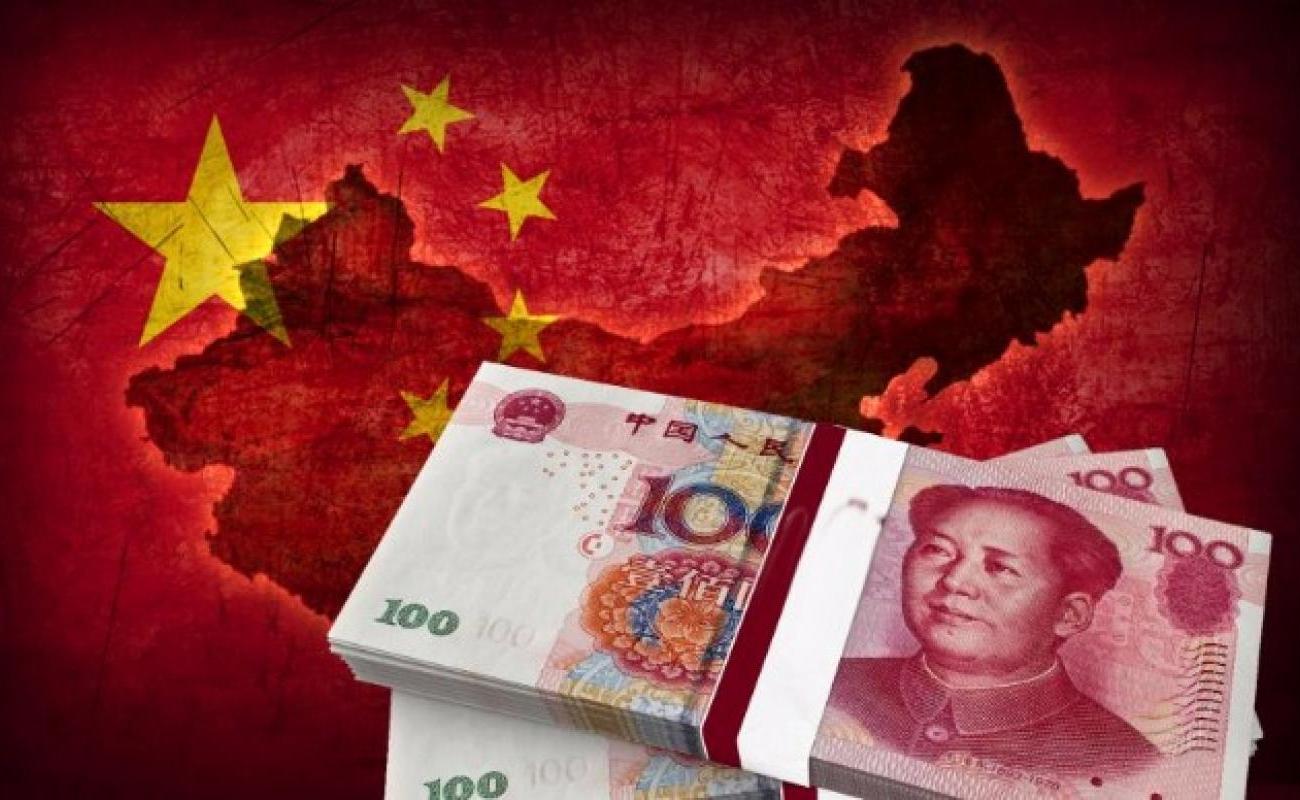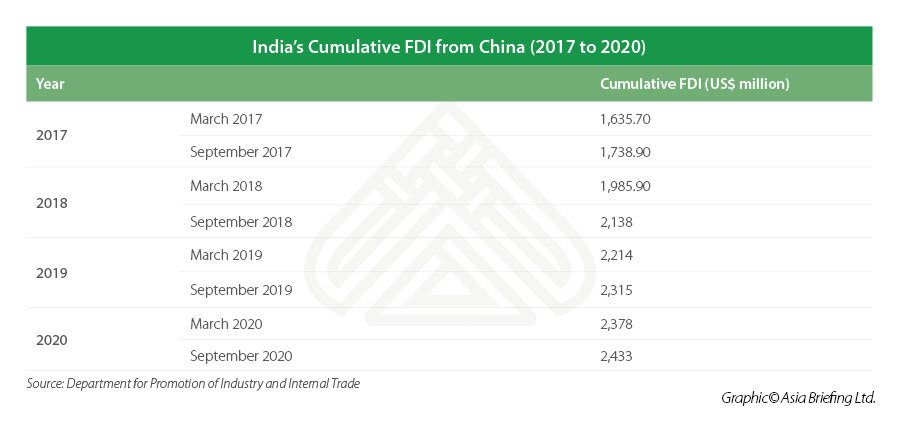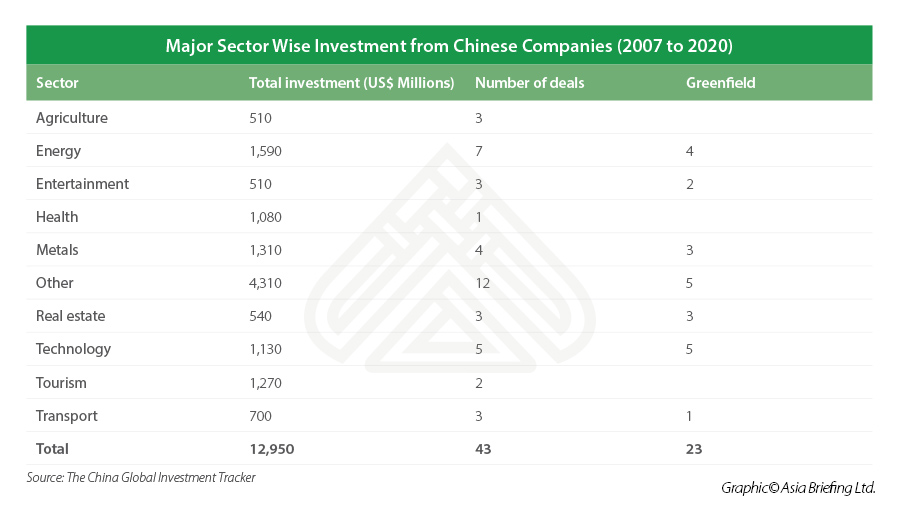India Rethinking its FDI Policy Stance with China: What We Know

In April 2020, the Indian government had revised its foreign direct investment (FDI) policy vis-à-vis its neighbors, including China, to prevent opportunistic takeovers of local firms during the pandemic. This was reiterated in the Consolidated FDI Policy, 2020 that came into effect October 15, last year.
As a result, investment from India’s neighboring countries would be allowed only after federal government approval, even in sectors where “automatic” clearances were previously permitted. Any changes in the ownership of shares – no matter how miniscule – would also require clearance from the federal government.
The increased scrutiny and subsequent stalling of Chinese investment proposals, however, coincided with clashes along the India-China border. Parallel to this, more than 100 Chinese apps were also banned by India, for security reasons, including ByteDance’s popular video-sharing app TikTok, Tencent Holdings’ WeChat, Alibaba’s UC Browser, and Tencent’s popular videogame PUBG.
India’s stance on restrictions affecting Chinese investment
Now, as geopolitical tensions appear to be subsiding – there have been reports that the government will be clearing Chinese FDI proposals after a nine month freeze. Speculation was rife after New Delhi cleared three new FDI proposals from companies based in Hong Kong in January 2021.
However, soon after, news outlets quoted officials denying any meaningful change in India’s stance. According to official sources quoted by news outlets, “The government of India has put in place a robust FDI policy. The amended policy says proposals from countries sharing borders with India have to go through security analysis and only after a thorough analysis can permission be given.” The same sources further add that the final decision on security assessment will rest with the Home Ministry. With regards to the proposals cleared in January, the sources stated: “These proposals were by Citizen watches, Nippon paints, and Netplay. Of the three, two are Japanese and one belongs to an NRI [non-resident Indian].”
New guidelines announced in March
Latest reports as of March 3 suggest that the Indian government will selectively consider Chinese investment proposals, while adhering to three-pronged standard operating guidelines. All Chinese investment proposals will have to undergo mandatory security clearances. The new guidelines are as follows:
- Large Chinese FDI in critical sectors: Any large-scale investment from China might be considered for approval in a critical sector where local companies have inadequate capacity.
- Companies headquartered elsewhere and routing FDI via Hong-Kong: Proposals from those companies that have their headquarters in countries other than China, and plan to invest in India, might be considered for approval.
- Small investment by Chinese investors: Those proposals entailing small investments by investors from China might also be considered for approval.
Without any official word from the government yet, it remains to be seen how the guidelines will be implemented. A positive development with respect to pending Chinese FDI proposals cannot be ruled out either.
Experts believe any easing of restrictions could be part of a larger agreement between New Delhi and Beijing to deescalate tensions at the border and attempt to restore parts of the relationship.
Meanwhile, no word is yet out on overturning the ban on Chinese mobile applications. According to a report from the analytics firm AppsFlyer, the market share of Chinese apps in India (tracked by share of installs) dropped to 29 percent in 2020 from 39 percent in 2019. Indian apps were able to leverage this vacuum by increasing their own market share to 39 percent in 2020.
Going forward New Delhi is likely to continue treating Chinese businesses and investments into India with an abundance of caution, using the security and sovereignty card – not dissimilar to Beijing’s own policy in the internet and technology sphere. Chinese FDI garners attention due to the blurred lines of separation between state-owned enterprise (SOE) and private enterprises in the country. This attention becomes even more relevant with Chinese firms and Chinese-invested firms acquiring controlling stakes in Indian companies, particularly in the technology sector, where definitions of security or strategic implications are rapidly evolving.
In early January, China had raised concerns with the World Trade Organization (WTO) over the harmful impact of New Delhi’s FDI restrictions. This was brought up during India’s trade policy review at the WTO; the US and European Union flagged India’s trade barriers, including high and fluctuating import duties, at that review.
Reading between the lines – official tone flip-flops on relaxing scrutiny
Since the 2020 FDI restrictions, several Chinese outbound investment proposals have been stuck in limbo.
According to India’s government data, since April 2020, the country has received over 120 foreign direct investment (FDI) proposals worth INR 120 billion (US$ 1.63 billion) from China. Most of these investments are for brownfield projects. The new FDI policy has redirected all these incoming proposals to the government approval route, but owing to the recent border standoff, no clearances have been given as of yet. This resulting pile up is hurting the expectations of Chinese companies in India and Indian companies in need of Chinese funding.
Initial positive reports suggested several relaxations to Chinese investors keen on Indian markets. They include the following:
- Approvals may be given to some Chinese greenfield investment proposals if they are not sensitive to national security.
- As for brownfield projects, FDI proposals that are not a risk to national security may be cleared after the first round of clearance to greenfield investments.
- Investments for stakes of up to 25 percent in “non-sensitive” sectors like heavy machinery, automobile parts, services and technology, which don’t have any security implications may revert to the automatic route for nations with which India shares land borders.
New bureaucratic clearance process
To help smoothen the process, the federal government has set up a coordination committee comprising of bureaucrats from key ministries – Home Affairs, External Affairs, Commerce and Industry, and Niti Aayog, the government’s policy think tank. This inter-ministerial coordination committee will scrutinize FDI proposals from all neighboring countries, but they will ultimately be screened by the concerned ministry, which will have a final say.
Chinese investment in India
Though the political ties between India and China date to 1950, bilateral trade relations were established in the mid-1980s, picking up pace since the early 2000s. Between April 2000 and September 2020, India received US$2.43 billion in FDI from China. In 2020, despite a temporary setback in the relationship, China continued to remain India’s largest trading partner with bilateral trade at US$77.7 billion.
The India China bilateral trade relationship was a lopsided and transactional one in the initial decade (2000-10) and driven by Indian purchases of Chinese machinery and equipment, which accounted for more than half of the total Indian imports from China. However, starting from 2014, this transactional pattern witnessed a shift towards deep rooted investments. The shift could be attributed in part to a favorable investment climate and facilitative governmental policy.
Since then, Chinese companies have actively invested in India’s development and industrial capacity-building, with an aim to establish long-term presence. They have adopted a multipronged approach, tapping into hyperlocal start-ups (reminiscent of the Chinese landscape 10 years ago), acquiring local firms, and developing joint venture strategies with Indian companies to give them acute access to the Indian market, across industries.
Sectoral composition of Chinese investments in India
Regardless of the hype, the actual proportion of Chinese FDI received by India constituted only US$2.43 billion (0.51 percent) of total inflows. According to the Ministry of Commerce and Industry, the majority of this FDI inflow from China happened between April 2014 to March 2019 (US$1.81 billion), with the automobile (US$876.73 million), electrical equipment (US$152.5 million), and services sectors (US$127 million) receiving the largest share.
India’s pharmaceutical sector was also a major recipient of Chinese FDI. The Shanghai-based drug firm Fosun Pharma acquired a 74 percent majority stake in the Hyderabad-based pharmaceutical manufacturing and R&D firm Gland Pharma in 2017, at a valuation of US$1.08 billion, according to The China Global Investment Tracker.
2016 onwards, India’s technology space began to see an influx of private Chinese capital. Dozens of Chinese technology firms and venture capital players – led by tech giants Alibaba (in Paytm, BigBasket, and Zomato) and Tencent (in Ola, Flipkart, and BYJU’s) – acquired minority or controlling stakes in Indian start-up unicorns. According to data from Invest India, leading Chinese smartphone makers OPPO, VIVO, Xiaomi, and Huawei have all secured 100 percent FDI for contract manufacturing of electronic gadgets in India and have set up plants in the states of Uttar Pradesh, Andhra Pradesh, and Tamil Nadu.
The Chinese automotive company SAIC, which conducts R&D, manufactures, and sells passenger and commercial vehicles, also has a presence in India. Its India operations include a former General Motors company that it acquired and currently has a production capacity of 80,000 units per year. SAIC Motors UK’s subsidiary MG Motors has also registered its presence in India. BYD Auto Co successfully launched electric buses in 2020. Other Chinese automotive companies whose proposals are in the pipeline awaiting approval include Changan, which was earlier slated to start operations in 2022-23, and Great Wall Motors (GWM).
Commenting on the blocked proposals and possible easing of tensions between India and China, the former National Security Advisory Board Chairman Shyam Saran was quoted saying to the media that: “If [the GM-GWM deal] is going to be cleared that seems to suggest that part of the overall deal between the two sides may also begin untangling the commercial and economic issue”.
On its part, India is actively pushing for greater foreign investment in target sectors, such as electronics and auto manufacturing, to supply its vast market needs, reduce import dependencies, create jobs, move up the value-add chain etc.
For now, it’s still ‘wait and watch’ mode
The state of commercial relations between India and China will impact the world economy – given their respective market sizes and levels of trade, business, and investment engagement.
Industry analysts and emerging markets watchers will be keenly watching how the two giants negotiate and move past political hiccups.
Amid the ongoing pandemic and nascent vaccine roll-out – prolonged disruptions and stalled movement of trade and capital will be costly to all sides.
This article was originally published on March 2, 2021. It was last updated on March 5, 2021 to reflect additional developments.


